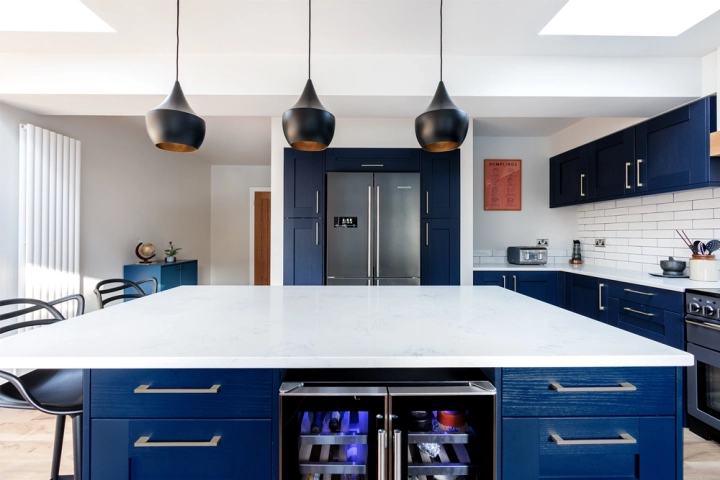
On The Surface
Choosing a work surface for a new kitchen can be difficult, compounded by the huge and seemingly endless choice of materials and wide range of prices. This is one of the most expensive elements of a new kitchen and can make or break its overall function and looks.
STONE
This is a more expensive choice of material. Granite used to be a favourite choice and looks beautiful, but it is porous which can allow bacteria to collate, and it can stain. It is also extremely heavy so comes with a high installation cost. Manufactured quartz is a great option as it comes sealed with an antibacterial protected layer and is lighter, yet still has that wonderful cold-to-the-touch nature that bakers love
WOOD
Those of you familiar with my kitchen designs will know that I love using wood. There are so many varieties available offering delightful textures and natural colour tones, from classic oak and maple to the various walnuts, cherry, iroko or even the environmentally sound bamboo. Wood is a classic, timeless material and fits perfectly into the natural, raw pared-down look that is key right now. My clients often ask if wooden worktops require maintenance and the answer if yes, although not as much as you might think. Bi-annual re-oiling is recommended by most suppliers, but this can be done very quickly and easily. It is also important to choose the best quality wood you can afford. It should be properly aged, ideally slow grown, and responsibly sourced to avoid future splitting of the staves, and the surfaces should be oiled rather than lacquered. The wider and longer the stave, the more expensive it will be. However, if cared for properly, its difficult to find a better kitchen work surface for your money and it will last a lifetime.
SOLID ACRYLIC
This type of material can be confusing as there are so many different brand names and because the quality can vary considerably. Corian is perhaps the best-known brand. This type of surface is MDF coated with a layer of solid acrylic which should be at least 12mm thick. The positives are that it can be moulded into almost any shape and thickness and there are no visible joins - a designer's Plasticine! The negatives are that, whilst scratches can be buffed out professionally, it does scratch fairly easily, and this is more visible on dark surfaces. Also, good quality solid acrylic surfaces can be extremely expensive.
LAMINATE
This is a good option for those on a budget. The good news is that in recent years the quality and choice of colour and finish of laminate surfaces has improved. Gloss laminate can look lovely, but again a dark gloss will show scratches. If installed correctly it can be a hard-wearing surface, but once those edges start to peel there is nothing to be done but replace the worktops.
